This article is my personal breakdown of the 2019 wide receiver draft class in, pre-combine and specifically from tape review. These rankings relate specifically to how these players will translate to fantasy football.
I’m positive these rankings will change as the NFL Draft process progresses, but this makes for a great starting point. I will also note that this article was written during Senior Bowl week-and it doesn’t include some players that had great weeks. Barring poor tape review, Penny Hart, Hunter Renfrow, Terry McLaurin will likely be added to my rankings update article (to come post combine). Let’s talk about them-let me know what you think on twitter!
For more on the fantasy football values of the 2019 Draft Class, check out the 48 Report: our 2019 Rookie Database

DRAFT is a fun, non-intimidating way to play DFS year round! They have 2019 Best Balls running already, & daily NBA contests. Get a free entry by using promo code “Top2” with your first deposit.
17. DeMarkus Lodge (6’2”, 200), Ole Miss
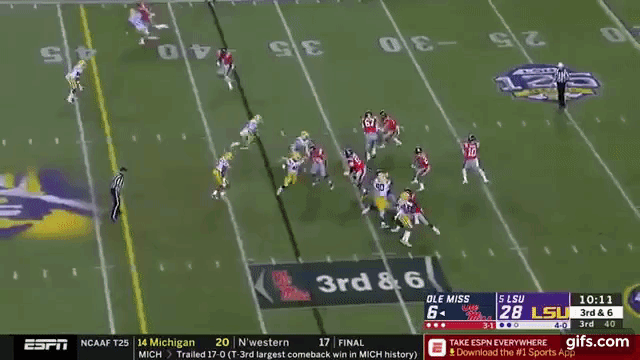
Lodge played in a dynamic Ole Miss offense; one with 2 other wide receivers (A.J. Brown, Metcalf) that are much higher on my list. In his senior year, in which Metcalf missed half the season, he caught 65 balls for 877 yards and 4 touchdowns. Metcalf, who played in just 7 games finished with more touchdowns (5) than Lodge. A.J. Brown finished with 2 more touchdowns, and 443 more yards. Lodge was snubbed from a Senior Bowl invite, and instead participated in the Shrine Game week of practices; although he did not play in the game.
Lodge came off very slow on tape; he displays limited acceleration and can’t burn defensive backs consistently. He’s inconsistent on jump balls-despite his size he rarely uses his body to position himself for success. Lodge has good footwork and works a decent route tree; for me, this is his best trait. He’s an average blocker, and Ole Miss often ran the ball away from him.
He occasionally flashes big play athleticism, but it’s very inconsistent. Lodge finds himself at the bottom of my list; he flashes upside in his athletic ability and route running but his inconsistency, lack of acceleration, and inability to pull down contested balls often makes me skeptical that he will make an impact early in his NFL career.
16. Greg Dortch (5’9”, 170), Wake Forest

The play finishes with a great example of his athleticism and hands.
Dortch, the 20-year-old Redshirt Sophomore out of Wake Forest has a lot of people excited. In just two seasons he’s racked up 142 receptions, 1800 receiving yards, and 17 touchdowns vs ACC defenses. Dortch had big games against Duke (10 receptions for 124 yards, 1 touchdown) and Louisville (8 receptions, 135 yards) but struggled against tougher teams like Notre Dame (6 receptions, 56 yards) and Clemson (3 receptions, 37 yards).
Dortch is a good route runner; he has quick feet and creates separation at the line of scrimmage. He has a fairly diverse route tree and works primarily, but not exclusively, out of the slot. He is quick, but not necessarily speedy-he doesn’t torch defenders over the middle, but he can be effective on end arounds. I’m not impressed by his blocking, and his athleticism seems limited for me. My biggest concern for Dortch is his hands: he struggles to make contested catches and during tape review I saw him drop multiple easy balls. He got overpowered multiple times when trying to go up and grab a ball.
At the right draft position (3rd round) he could provide nice value for your dynasty rosters-but Dortch is seriously raw and I don’t seem him translating quickly to the NFL game. I think he would’ve been better served with another year in college.
15. JJ Arcega-Whiteside (6’3”, 225), Stanford

Arcega-Whiteside was a 3-year starter at Stanford, culminating with a senior season with 63 receptions, 1,059 receiving yards, and 14 touchdowns. Arcega-Whiteside is a big bodied receiver that built a lot of hype after finishing the 2018 season with 90+ receiving yards in 6 of his last 7 games.
Arcega-Whiteside’s best trait is his route running. He has great footwork that allows him to create separation consistently. He rarely uses his hands, though, and has a limited route tree-still he has one of the meanest curl routes in the class. He’s not super athletic-but he is strong and that helps him box out defenders and win jump balls. It also helps him be an effective blocker. His speed is seriously capped, though, and he rarely beats a defensive back. Given his size, you’d hope to see a higher vert from him, instead you see limited ability to jump and a reliance on his size to make catches.
Given the right landing spot, he could see a jump in my rankings. For now, though, his limited athletic ability and speed limit him to a redzone threat, which isn’t appealing for his fantasy football value.
14. Andy Isabella (5’10”, 190), University of Massachusetts
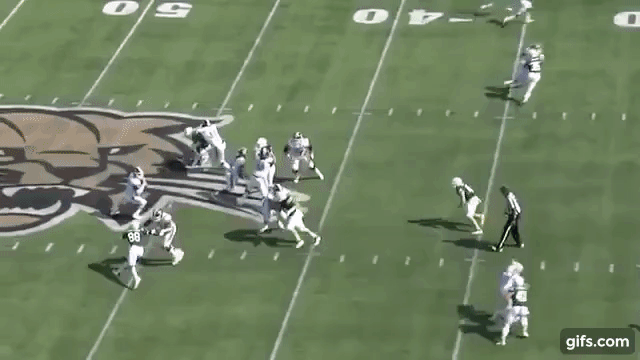
Isabella is one of the most hyped “small-name” prospects heading into the NFL draft season. He’s coming off back to back 1000+ yard seasons for FBS UMass (who play as Independents). In his senior season, Isabella totaled 1,698 receiving yards; 1st in the FBS by over 200 yards. Don’t take his small school lightly either; the Minutemen played tough opponents that Isabella excelled against. He caught 5 receptions for 96 yards against Boston College, 13 receptions for 191 yards and a touchdown against South Florida, and 15 receptions for 219 yards and 2 touchdowns against Georgia.
Tape is limited on Isabella so my review for him is a bit short and fairly limited; so, he may vary a lot in my rankings throughout the draft process. What’s clear from the tape is that he’s quick, seriously quick. He can move vertically and horizontally, displaying dangerous go routes and the ability to hit the edge on a reverse. His route tree didn’t impress me (again, limited tape) but he really loves running the slant out of the slot (and he’s good at it, too).
His hands are a serious concern for me: he had the ball ripped out of his hands multiple times in contention, and rarely extends his arms fully when pulling in balls. NFL teams need slot receivers and if Isabella is a late round score for a dangerous offense he value will skyrocket-there’s just not enough there for me yet, though.
13. Anthony Johnson (6’2”, 207), Buffalo
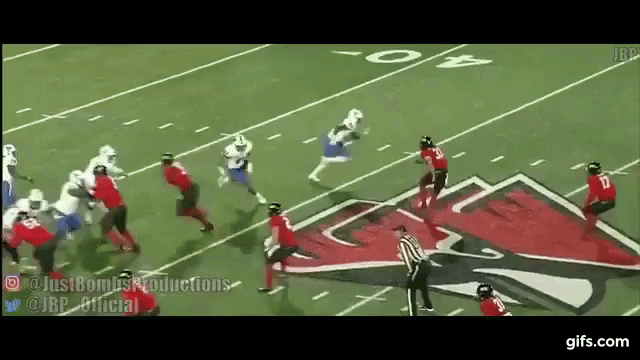
You may only recognize Anthony Johnson from Tyree Jackson tape, that’s a mistake-this dude can play. He totaled 133 receptions, 2,367 receiving yards (17.8 yards/catch), and 25 touchdowns in his final two seasons at the University of Buffalo. In his senior season, he had 4 games with at least 95 receiving yards and caught touchdowns in 7 of his 11 match-ups. Although he primarily faced MAC defenses, he did catch 2 balls for 101 yard and a touchdown vs Rutgers.
It’s tough for me to rank Johnson this low-there’s a lot of good in his game. He works a decent route tree, but it’s primarily in the short field: drags, short outs, and screens off the line of scrimmage, and curls (seriously, so many curls) dominate his tape. He’s a solid blocker, but doesn’t work over guys like some of the other bigger bodied receivers in this class do. He has solid hands, but really struggles to put his body in a position to win contested balls.
He has good athleticism and is a YAC threat, but his speed is capped; making him essentially a N’Keal Harry-lite on tape. There’s a lot to like watching Anthony Johnson tape, there’s not just enough to love.
12. Riley Ridley (6’2”, 200), Georgia

Ridley played in 28 games for the Bulldogs, but totaled just 69 receptions, 1,015 yards, and 13 touchdowns. His best senior was his junior year (2018): he pulled in 43 balls for 559 yards and 9 touchdowns. Ridley is being used as the example of much debate in the fantasy football and NFL Draft communities: he seems to be a non-negotiable between analysts and scouts that love his tape and analytic-minded writers whose models reject his poor performance in one of the best offenses in the nation in 2018.
I find myself somewhere in between: I watch tape, and as much as I respect analytics models, I don’t use one and I haven’t created one myself-so I’ll focus on the tape. He’s fast, but not likely in the top 5 of wideouts in this class. Ridley has great footwork but fails to use his hands to create space at the line of scrimmage or in contested situations. He hasn’t mastered a full route tree, but does work well when running slants, curls, posts, and 9 routes. He has solid hands, I rarely saw him drop balls in his tape. He has great athleticism and his big play potential is why many will fall in love with Ridley. I like Ridley, and I see the appeal but as his ranking indicates-he doesn’t standout compared to the upside I see in a lot of the guys in this talented wide receiver class.
11. Emanuel Hall (6’3”, 195), Missouri

Emanuel Hall recorded back to back 800+ yard seasons in his junior and senior seasons with Drew Lock at the University of Missouri. In those two seasons, he averaged 23.6 yards per reception and pulled in 14 touchdowns. Hall’s senior season was cut short (8 games) but he had 3 games with at least 150 receiving yards and had 2 games with multiple touchdowns. He had just 1 game with less than 70 receiving yards and found the endzone in half of his games.
Hall is a big play threat, one fantasy football players could come to love. He’s quick off the line of scrimmage and has top-end acceleration. He consistently beats SEC defensive backs. He has subtle hands and good awareness when going up for balls-he consistently adjusted to, and caught balls thrown behind him. He really doesn’t drop footballs. His route tree is limited: it was primarily go routes and slants at Missouri, and his vertical seems limited from tape. Still, his speed and ability to work along the sideline is appealing-he could shoot up my rankings with a landing spot that will compliment his skillset.
10. Marquise “Hollywood” Brown (5’10”, 168), Oklahoma
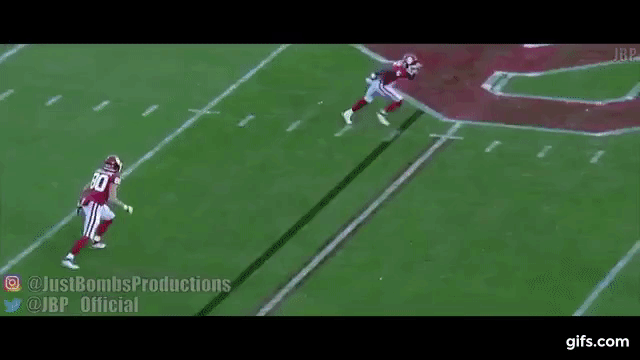
Marquise Brown, the cousin of Antonio Brown, flashed at Oklahoma in his senior season with Kyler Murray. He caught 75 passes for 1,318 yards (18.3 yards/reception) and 10 touchdowns. Hollywood had some huge games this season-6 games with at least 130 yards, including an 11 reception, 243 yard and 2 touchdown games against West Virginia.
Brown will likely finish as one of the three fastest 40 times at the NFL Combine. He’s quick off the line of scrimmage, and perhaps it’s the fact they’re Big 12 defenders but even when defensive backs lined up 12 yards off the line of scrimmage, Brown burned them. He creates serious space with his slant route, but essentially depends on that and his vertical routes to perform. He has a serious motor when blocking and doesn’t mind engaging with a defender and churning his feet to drive him back-a noticeable quality for a player of his size.
He has decent hands, but benefited from Murray putting the ball on spot often-he showed no capability to making a play out of a bad pass. His vertical seems limited, and he often tries, but fails, to make men miss in space. In 5 years, Hollywood very well may be a top 3 receiver from this class-but as John Ross has proved to us: speed isn’t everything and his limited route tree is seriously concerning. Don’t let Big 12 stats convince you to take a shot on this receiver.
9. Deebo Samuel (6’0”, 210), South Carolina
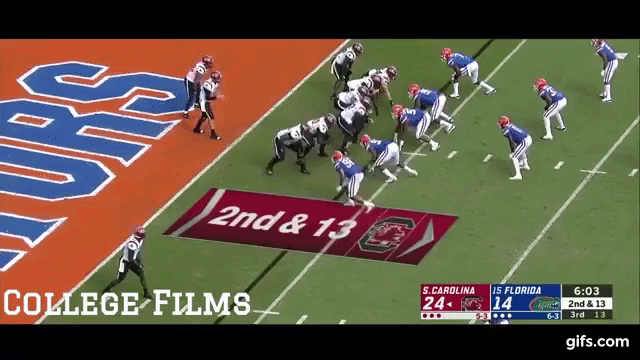
Deebo Samuel impressed early in his career for the Gamecocks: pulling in 59 receptions, 783 receiving yards, and a touchdown in his sophomore season. After injury cut his junior year short, he pulled in 62 receptions for 62 yard and 11 touchdowns in his senior year in Columbia. Samuel also has 25 carries for 154 yards and 7 touchdowns in his career (98 yards, and 6 touchdowns came in 2016).
Samuel is fast: he torched the Clemson secondary and consistently moves quickly in space. Samuel is quick off the line of scrimmage and isn’t afraid to use his hands and body to get physical when trying to create space or lay a block. He has good balance, and can absorb contact and stay on his feet when taking hits. From returning kicks to running end-arounds, NFL coaches will fall in love with his versatility. His route tree isn’t impressive, though, it’s primarily slants and screen off the line of scrimmage. He also struggles to catch contested passes, rarely bringing in catches when he’s not operating in space. He’s destined for the slot, but with the recent success of players like Kupp and Coutee, that shouldn’t scare off fantasy players.
8. Parris Campbell (6’1”, 208), Ohio State
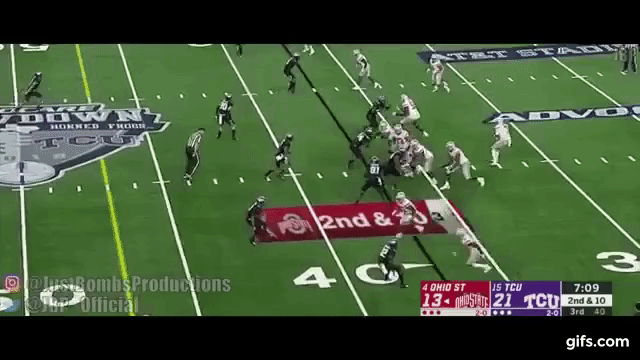
After 3 pedestrian seasons for the Buckeyes, Campbell’s stock rose from a senior season that included 1,063 receiving yards, 90 receptions, and 12 touchdowns. Campbell impressed against Michigan-catching 6 passes for 192 yards and 2 touchdowns. The shootout against the Wolverines was 1 of 3 games where Campbell pulled in at least 140 receiving yards. Campbell, though, also had 9 (out of 14) games with less than 70 receiving yards, and 5 games below 50 receiving yards.
Campbell is all around fast-he’s quick off the line of scrimmage, he creates a ton of space when running routes, and can accelerate up the sideline. Campbell has solid hands-he catches almost everything sent his way, which can often require adjustments on passes off the mark from Haskins. Campbell was wide-open on almost a lot of the receptions he made, a testament to his route running ability; but he primarily ran slants, curls, and drags-fairly simple routes. He is athletic and teams will like his versatility-he can be effective on reverse players, work out of the slot, catch passes at the line of scrimmage, or run a 9 route from the outside (although he primarily lined up stacked, or in the slot).
Campbell is getting a lot of hype from the NFL Draft community, and personally considered his stock to be above the Senior Bowl. He could be a late 1st/2nd round NFL draft target and has top 5 wide out potential, if he finds himself in the right spot.
7. Jalen Hurd (6’4”, 217), Baylor
I’m higher on Hurd than most, and I’ll admit now that I had the chance to watch Hurd live while attending school at the University of Tennessee-but this player serious upside, and isn’t being talked about-a formula that could equate to serious fantasy football value. Hurd ran for 899 rushing yards, 5 touchdowns, and caught 35 receptions for 221 yards as a freshman running back (yes, running back) at the University of Tennessee. In his sophomore year, still at Tennessee and still at running back, he ran for 1,285 rushing yards and 12 touchdowns while catching 22 receptions for 190 yards and 2 touchdowns.
Halfway through his junior year (2016), Hurd was receiving serious NFL Draft consideration, with talk indicating he could be a first round pick. Hurd decided he wanted to switch to wide receiver-a position he believed would allow for him to have a longer and more lucrative NFL career. After the Butch Jones led Tennessee coaching staff refused to grant him the position change, Hurd announced his decision to leave Rocky Top; he later announced a transfer to Baylor. Note: Hurd’s transfer allowed Alvin Kamara to take on the starting job-a role he could not beat Hurd for.
As a wideout in a rebuilding Baylor offense, Hurd caught 69 passes for 946 yards and 4 touchdowns. Hurd was still utilized as a running back, though, and rushed the ball 48 times for 209 yards and 3 touchdowns. In total, Hurd finished his college career (which spanned 5 years) with 4,282 total yards from scrimmage (2,844 rushing and 1,438 receiving) and 33 touchdowns (23 rushing, 10 receiving).
Hurd moves quickly in space and burns along the sideline. He breaks guys with his speed and footwork in space, displaying elite running back and top level wideout skills-giving him serious upside potential. Hurd catches everything that comes his way; watching him work along the sideline and over the middle makes you understand why he wanted to make the position change.
He has serious athletic ability, and it wouldn’t surprise me if Hurd finishes top 3 in vert for the position at the Combine. Hurd’s route tree is limited, but I’m impressed with how crisp his routes are-for just one season at the position. He has great footwork that he uses to create space on curls and posts, and aggressive handwork that allows him to create space on drags and outs. He sells his route well, and often overwhelms Big 12 defenders.
Hurd is raw, and I’m hooked by his upside-so there’s risk in this ranking but I believe Hurd will stand out as the most valuable pick for fantasy football players from this draft class.
6. Lil’Jordan Humphrey (6’4”, 225), Texas
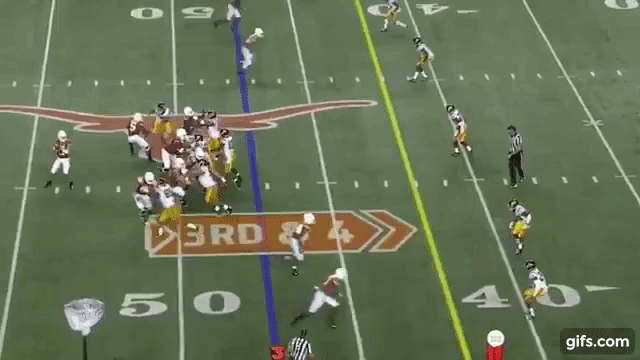
Humphrey’s name is equal parts amazing and ironic-he stands as one of the largest receivers in the 2019 class. Perhaps the only thing more impressive than his name is his junior season for the Longhorns: he caught 86 balls for 1,176 yards and 9 touchdowns. Humphrey, like most of the Big 12 prospects, had plenty of big games: catching 9 passes for 133 yards and a touchdown against the Sooners, 143 yards on 9 receptions for 1 touchdown against West Virginia, and 8 receptions for 159 yards and 2 touchdowns against Texas Tech. What’s impressive for me, though, is he put up good performances against solid non-conference competition too: 4 receptions for 84 yards and a touchdown against the Trojans of South California, 6 receptions for 82 yards against Maryland, and 7 receptions for 67 yards against Georgia in the Sugar Bowl.
Humphrey’s route running seriously impressed me: I saw examples of him working a seriously diverse route tree but in particular excels at ins, outs, curls, and drags. He also lines up in the backfield and stacked to take/fake reverses. Humphrey lines up primarily inside, which is odd for his size, but he dominates the middle of the field. He has decent hands, and solid body positioning but I’d like to see him develop this part of his game at the next level.
He doesn’t come off as the quickest guy on the field but he has good acceleration; a trait that helps him both as a wideout and kick returner. Humphrey likely won’t be ranked this high for many, but there’s a lot that I love with his tape-still, he’s fairly raw in a wideout class that has a lot of developed talent. Humphrey may slip in the NFL Draft and in your rookie drafts, but he is a big bodied, impressive, future highlight maker.

Fantasy Champs has the best championship gear around. They’re now offering Fantasy Football, Baseball, and Basketball custom engraved trophies, jerseys, rings, & belts. Save 10% with promo code “Top2”
5. A.J. Brown (6’1”, 225), Ole Miss
Brown was the driving force behind a high-functioning Ole Miss offense that has to be considered one of the most dangerous offenses in the SEC West over the past two seasons. In those two seasons, Brown caught 160 receptions for 2,572 yards and 17 touchdowns. Brown caught at least 6 passes in 10 of 12 games in his senior season: pulling in at least 100 receiving yards in 6 of those 12 games. He caught 6 for 115 against South Carolina, 10 for 155 and a touchdown against Auburn, 6 for 127 against Texas A&M, and 9 for 212 and a touchdown against Vanderbilt.
Brown works the middle of the field like no other wideout in this class. He’s fast off the line of scrimmage, creates spaces consistently with his speed, and is very agile when working in that space. He can accelerate across the field and hit the edge and burst up the sideline like an elite running back would. He has great footwork that makes his route running impressive, but his route tree is limited. He banks on his impressive slant route (I’m talking OBJ-esq quality), but I’d like to have seen more. He’s competitive on jump balls-often using subtle handwork and positioning to bring in jump balls, but isn’t automatic-he has some frustrating drops when contested.
Brown has serious YAC capability and it makes him even more appealing for fantasy football purposes. He is consistent, reliable, and has a lot of upside. He would do best in an offense where he can be the WR2-he’s not the highlight maker but he’s a coach’s dream. In a top tier offense, he will be an immediate fantasy football player’s dream too.
4. D.K. Metcalf (6’4”, 225), Ole Miss

Metcalf is one of the most intoxicating prospects in this draft-serious, put a towel on your desk when you’re watching his tape-because you will be drooling. Metcalf very well may be the first wideout to come off the board in April, and in turn your rookie drafts. His college profile, though, is limited: giving us limited tape and numbers to work off. Metcalf began his career in Oxford in 2016, but after just 2 games (and 2 receptions) suffered a season-ending broken foot. In his redshirt freshmen year (2017), Metcalf caught 39 balls for 646 yards (16.6 yards/catch) and 7 touchdowns. Just to clarify, he caught a touchdown on 18% of his receptions.
After 7 games with 26 receptions and 569 yards (21.9 yards/catch) in 2018, Metcalf suffering a season-ending neck injury. Metcalf has been cleared for football activities, but the combine will be essential for his draft stock. For now, though, we will focus on the tape.
Metcalf is fast, but not to the level of guys mentioned previously-like Hollywood Brown, Campbell, or Hurd. He has a limited route tree (to match limited tape/play time) but showed the ability to contribute in the short game with screens off line of scrimmage, and at the mid field with deeper curl routes, and downfield with a explosive 9 route. He has excellent footwork and sells defenders hard on inside moves-which allows him to get down the field with 3-5 steps on some of the best defensive backs in the nation. He’s seriously aggressive at the line of scrimmage and has tremendous handwork.
He uses his hands violently at the line of scrimmage and subtly in pass contention. He uses his large body well to position himself into easy catches. He has seriously impressive athleticism-I’d place my bets on him having the top vertical at the combine. He consistently catches contested passes in double coverage and has fantastic balance when taking hits both during and after passes. The play never seems over when Metcalf has the ball in his hands. I don’t blame you if you like Metcalf best in this class, and he’s close for me-but there’s a few guys that stand out as more finished players.
3. Hakeem Butler (6’6”, 225), Iowa State
Butler is the largest wideout in this class, and he could return the largest value of any first-round projected fantasy football rookie picks. Butler caught 41 receptions for 697 yards (17 yards/catch) in his redshirt sophomore year (2017) while bringing in 7 touchdowns. In 2018 he took his game to a whole new level: catching 60 balls for 1,318 yards (22 yards/catch) and 9 touchdowns. Butler’s 22 yards/reception was best in the Big 12 in 2018, and his 1,318 receiving yards was 8th best in the nation. Butler had 6 games (out of 13) with at least 100 receiving yards (and a 7th game with 99 yards). He balled out against the best competition in the conference (5 receptions for 174 yards and 2 touchdowns against Oklahoma) and against out of conference foes (9 receptions for 192 yards in their bowl game against Washington State).
Butler has great footwork which compliments a developed route tree. He has subtle, but convincing moves that allow him space against defenders when running curls, corners, posts, and slants. He has aggressive hands that allow him space when beating defenders at the line of scrimmage and opening up serious success when running vertical routes. Butler isn’t the fastest guy in this class-but he accelerates downfield and has quick movements.
He’s serious athletic and can go up and grab just about any ball-he works well over the middle and has great presence along the sideline. Butler can block too-I know not the flashiest thing to talk about but it’ll get him on the field; he literally throws defensive backs off him and finishes blocks to the end. He has fantastic extension and uses all of his long wingspan. On multiple occasions, you can find him dragging smaller defenders down the field.
Butler’s name might not carry the same weight as guys like Metcalf and Brown now, but come rookie draft season-it will.
2. N’Keal Harry (6’4”, 213), Arizona State
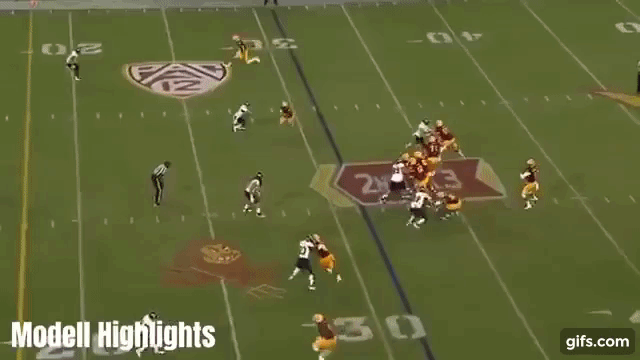
Harry racked up back to back 1,000+ yard seasons for Arizona State in his sophomore and junior seasons (2017 & 2018). In those seasons, he combined for 155 receptions, 2,230 receiving yards, 17 touchdowns, 20 rushing attempts, 75 rushing yards and a rushing touchdown. Harry finished 2nd in the Pac-12 in receiving yards in both of those seasons. In 2018, Harry had just 3 games (out of 13) with less than 80 receiving yards-and totaled 4 games with 100+. Harry’s stats aren’t as flashy as some of the other wideouts in this class, but he’s consistency is seriously attractive for fantasy football purposes-and was doing a lot with a little around him in Tempe.
Harry catches everything thrown his way (accurate or not). His ability to box out defenders with his body is perhaps the best of the class. He uses his hands to create significant separation when going up for contested passes. His footwork helps him create space at the line of scrimmage-often selling defenders and making them look silly.
His route tree is solid, but could use some expansion: he loves curls and slants but Arizona State really loved to put the ball in his hands at or behind the line of scrimmage. You can’t blame them for that-Harry is seriously dangerous when he has the ball in his hands. He’s quick and using his feet and vision in a way that mocks the best running backs in this class. He will make guys miss in space and isn’t afraid to smash the circle button on a line backer (that’s a spin move for my non-Madden players). He’s strong too: he gets physical with defenders when blocking and has the strength to throw would-be tacklers off him when running the ball.
Whether it’s the NFL or your rookie drafts, there’s always risk associated with making your selection-with Harry, so much of that risk is eliminated. He’s consistent, competitive, and has the athletic upside you can only dream of.
1. Kelvin Harmon (6’3”, 214), NC State
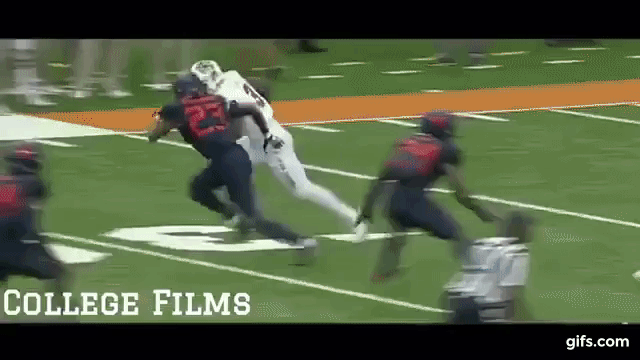
Harmon pulled in 69 receptions for 1,017 receiving yards and 4 touchdowns as a sophomore (2017) at North Carolina State. This was despite being in a run-heavy offense which featured 2017 draft picks Jaylen Samuels and Nyheim Hines. In 2018, he brought those impressive numbers up to 81 receptions for 1,186 receiving yards and 7 touchdowns against ACC opponents. He finished with 7 (out of 12) games with over 90 receiving yards and caught 6 receptions in 8 games. Harmon finished 6th in receptions and 2nd in receiving yards in the ACC in 2017, and 4th in receptions and 1st in receiving yards in 2018.
Harmon comes off as the most pro-ready wide receiver in the class to me. Harmon’s footwork is next level, it allows him to create separation on comeback routes that seem like automatic 7-12 yard gains and allow him to break the ankles of defenders in space. Harmon has the speed to burn defenders on 9 routes-giving him the big play potential every fantasy football player wants. More impressive, though, is Harmon’s short to mid field work. In addition to footwork, Harmon’s handwork allows him to create separation at the line of scrimmage immediately and consistently.
I’m low-key in love with Harmon’s ability to subtly, but effectively, use his hands to create spaces on contested space. This combination makes him a intoxicating combination of a PPR dream and the big play upside that makes fantasy players fantasy champions.
Harmon also has one of (if not the best) high point in this draft class. He’s extremely long and athletic and is able to extend his body to make even the worst Ryan Findley throw catchable. He consistently adjusts to bad passes with quick reactions, and high level of awareness. He has top level presence along the sideline and has great balance. Harmon is also a great blocker-he seeks contact with defenders and has great mechanics when holding blocks, not the flashiest skill to have but it should allow him to get on (and stay on) the field early in his NFL career.
Harmon’s upside might not be the same as Metcalf, and his stats might not be as padded as A.J. Brown-but he checks all of the boxes, and consistently performs at a high level in an offense that wasn’t made for his success. His tape is impressive and he’s ready to contribute to an NFL offense. I expect him to have a successful combine, and baring a tough landing spot he will be my 1.01.



Great read. Also you might want to take a once over of deebo samuel you said he had 62 rec for 62 yd. Just a heads up
LikeLike